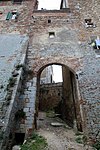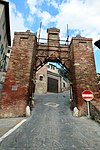Chianciano Terme
| Chianciano Terme | ||
|---|---|---|

|
|
|
| Country | Italy | |
| region | Tuscany | |
| province | Siena (SI) | |
| Coordinates | 43 ° 4 ' N , 11 ° 50' E | |
| height | 475 m slm | |
| surface | 36.52 km² | |
| Residents | 7,025 (Dec 31, 2019) | |
| Population density | 192 inhabitants / km² | |
| Post Code | 53042 | |
| prefix | 0578 | |
| ISTAT number | 052009 | |
| Popular name | Chiancianesi | |
| Patron saint | San Giovanni Battista (June 24th) | |
| Website | Chianciano Terme | |
 Panorama of Chianciano (old town of Chianciano Terme) |
||
Chianciano Terme is an Italian commune with 7025 inhabitants (as of December 31, 2019) in the province of Siena in the Tuscany region .
geography
Chianciano Terme is located approx. 50 km southeast of the provincial capital Siena and 90 km southeast of the regional capital Florence between the valleys of the Chiana and the Val d'Orcia . It lies in the climatic classification of Italian communities in Zone E, 2 152 GG. The local churches belong to the diocese of Montepulciano-Chiusi-Pienza .
The neighboring municipalities are Chiusi , Montepulciano , Pienza and Sarteano .
history
The area around today's old town ( Chianciano paese ) was already settled by the Etruscans , later the Romans were there. Both peoples already used the warm water of the thermal baths , which are located south of Chianciano. The name arose from the name Cis Clanis (behind the Chiani, today's Chiana). The place was documented for the first time in 1072. From the 12th century the Chianciano was subordinate to the Counts of Manenti. They remained in power in the place until the early 13th century, when the Republic of Siena took the Manenti castle around 1230. After that, the place was a free commune in the territory of Orvieto and was taken over by Siena in 1349. After the defeat of Siena by Florence in 1555, the place came to the Grand Duchy of Tuscany a little later .
The modern facilities of the thermal baths were built from 1915 and were significantly expanded in the 1950s and 1960s.
Attractions
- City walls from the 13th century with the city gates Porta Rivellini (main gate, western gate of the city walls), Porta San Giovanni (northern gate) and Porta del Sole (southern gate)
- The Collegiata di San Giovanni Battista is a church built in 1229 in Via Solferino (old town of Chianciano). The facade dates from the late 13th century. It has had the title of Collegiata since 1674 and was renewed and expanded by Luigi De Vegni from 1813 to 1817. Contains the fresco Presepe that the Rustichino is attributed, and the statue Cristo Morto by Giuseppe Paleari (1753).
- The church Chiesa dell'Immacolata is located in the old town of Chianciao and was built in 1475 over the walls of a hospital documented since 1272, at that time still under the name Santa Maria della Stella . It was destroyed in the conflict between Siena and Florence in 1555 and rebuilt in 1580 under the name Chiesa della Morte . In 1958 it was given its current name and contained the fresco Madonna della Pace by Luca Signorelli (attributed, now in the Museo della Collegiata).
- Chiesa della Compania della Croce , church built in the 16th century to the right of the Collegiata in Via della Croce, to which the cemetery is connected. The canvas painting San Carlo Borromeo is attributed to Bernardino Mei .
- Museo della Collegiata , is located in the Palazzo dell'Arcipretura in the old town of Chianciano.
- Chiesa dei Santi Fabiano e Sebastiano , church built in 1476 on today's Piazza Matteotti. Was inactive between 1784 and 1800 and is now privately owned.
- The Madonna della Rosa church is a church built between 1585 and 1599 based on plans by Baldassarre Lanci (designed in 1569). The name comes from the fresco Madonna che dona una Rosa al Bambino tra San Giovanni Battista e San Bartolomeo , work of an unknown Senese artist from the 15th century (high altar).
- Museo Civico Archeologico delle Acque , archaeological museum on Via Dante.
- Museo d'arte di Chianciano , art museum in Viale della Libertà.
- Sant'Antonio , church started in 1933 near the thermal baths. Was expanded and renewed until 1965.
- Santa Maria della Stella , church consecrated in 1969 near the thermal baths.
- Villa Simoneschi , Pacchierotti's villa built around 1830 on Via Dante.
traffic
The Chiusi-Chianciano Terme train station is on the Florence-Rome high-speed line , which is part of the Berlin-Palermo railway axis . It also connects Siena and Empoli with this route. The night trains , which run from Munich or Vienna to Rome under the name ÖBB Nightjet , also stop in Chiusi-Chianciano Terme.
The place has the motorway junction Chiusi-Chianciano Terme on the A1 ( Autostrada del Sole ).
Town twinning
Chianciano Terme has had a partnership with the Czech city of Marienbad since 2000 .
literature
- Laura Martini (ed.): I Luoghi della Fede: Montepulciano e la Valdichiana senese. Arnoldo Mondadori Editore , Milan 1999, ISBN 88-04-46787-8 , p. 139 ff.
- Emanuele Repetti: CHIANCIANO (Clanciaum) in Val di Chiana. In: Dizionario Geografico Fisico Storico della Toscana (1833–1846). Online edition of the University of Siena (PDF, Italian)
- Touring Club Italiano : Toscana. Milan 2003, ISBN 88-365-2767-1 , p. 761 ff.
Web links
- Official website of the municipality of Chianciano Terme
- Website of the Pro Loco in Chianciano Terme
Individual evidence
- ↑ Statistiche demografiche ISTAT. Monthly population statistics of the Istituto Nazionale di Statistica , as of December 31 of 2019.
- ↑ Website of the Agenzia nazionale per le nuove tecnologie, l'energia e lo sviluppo economico sostenibile (ENEA), accessed on October 6, 2016 (Italian) (PDF; 330 kB)
- ↑ a b c d e f g h i Laura Martini (ed.): I Luoghi della Fede: Montepulciano e la Valdichiana senese.
- ↑ a b c d Touring Club Italiano: Toscana.
- ↑ Website of the Museo della Collegiata Chianciano , accessed on October 7, 2016 (Italian)
- ↑ Website of the Museo Civico Archeologico delle Acque , accessed on October 7, 2016 (Italian)
- ↑ Website of the Museo d'Arte in Chianciano Terme , accessed on October 7, 2016 (Italian)
- ↑ Villa Simoneschi ( Memento of the original from October 7, 2016 in the Internet Archive ) Info: The archive link was inserted automatically and has not yet been checked. Please check the original and archive link according to the instructions and then remove this notice. , Website of the municipality of Chianciano Terme, accessed October 7, 2016 (Italian)









